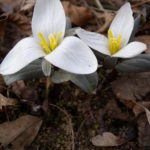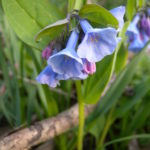
Snow trillium
As I type this article, the outside thermometer is showing 10 degrees F. Ouch! And the calendar reads March 4. Double ouch! Winter is stubbornly hanging around for a few more days, maybe weeks. Eventually, the dreary cold weather will surrender to spring and life will return to the woods. However, subtle changes are occurring now if one looks closely. Through a process called plant thermogenesis, heat is generated in the spadix of skunk cabbage. This allows the spadix, a flowering structure, to emerge from the cold ground, even through a blanket of snow, to claim the title as the first native plant to flower in the woods. Days later as the ground soaks up the sun’s warmth a plethora of spring ephemerals will blossom and convert a brown landscape into a colorful bouquet of floral delight. This is the time of year I most enjoy taking a walk through the woods.

Virginia bluebells
If you would like to learn more about woodland wildflowers, a guide is now available to help nature lovers identify these beautiful plants. The book, called Into the Woods, is a color photo guide of woodland wildflowers and other unique plants. It contains a glossary of botanical terms, flower color index, alternate plant names, flowering dates, pollinator information, plant status (native, non-native or invasive) and detailed plant descriptions. You can search for the book online through Amazon.com (search: Into the Woods Dan Childs).